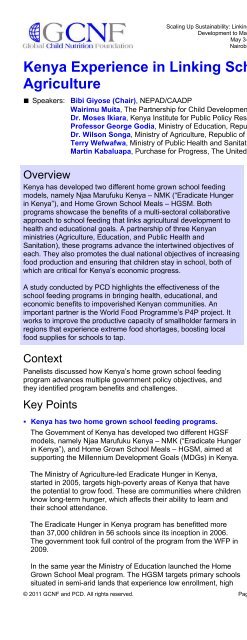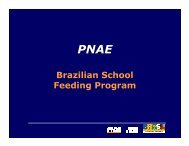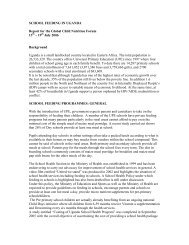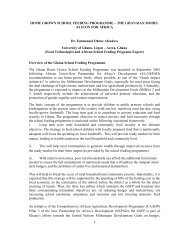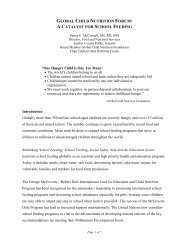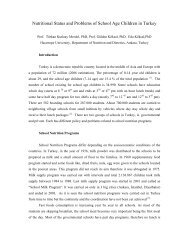EXECUTIVE SUMMARY - Global Child Nutrition Foundation
EXECUTIVE SUMMARY - Global Child Nutrition Foundation
EXECUTIVE SUMMARY - Global Child Nutrition Foundation
Create successful ePaper yourself
Turn your PDF publications into a flip-book with our unique Google optimized e-Paper software.
Scaling Up Sustainability: Linking School Feeding with Agriculture<br />
Development to Maximize Food Security<br />
May 3-7, 2011<br />
Nairobi, Kenya<br />
Kenya Experience in Linking School Feeding to Small-Holder<br />
Agriculture<br />
■ Speakers: Bibi Giyose (Chair), NEPAD/CAADP<br />
Wairimu Muita, The Partnership for <strong>Child</strong> Development (PCD)<br />
Dr. Moses Ikiara, Kenya Institute for Public Policy Research and Analysis<br />
Professor George Godia, Ministry of Education, Republic of Kenya<br />
Dr. Wilson Songa, Ministry of Agriculture, Republic of Kenya<br />
Terry Wefwafwa, Ministry of Public Health and Sanitation, Republic of Kenya<br />
Martin Kabaluapa, Purchase for Progress, The United Nations World Food Programme (WFP)<br />
Overview<br />
Kenya has developed two different home grown school feeding<br />
models, namely Njaa Marufuku Kenya – NMK (“Eradicate Hunger<br />
in Kenya”), and Home Grown School Meals – HGSM. Both<br />
programs showcase the benefits of a multi-sectoral collaborative<br />
approach to school feeding that links agricultural development to<br />
health and educational goals. A partnership of three Kenyan<br />
ministries (Agriculture, Education, and Public Health and<br />
Sanitation), these programs advance the intertwined objectives of<br />
each. They also promotes the dual national objectives of increasing<br />
food production and ensuring that children stay in school, both of<br />
which are critical for Kenya’s economic progress.<br />
A study conducted by PCD highlights the effectiveness of the<br />
school feeding programs in bringing health, educational, and<br />
economic benefits to impoverished Kenyan communities. An<br />
important partner is the World Food Programme’s P4P project. It<br />
works to improve the productive capacity of smallholder farmers in<br />
regions that experience extreme food shortages, boosting local<br />
food supplies for schools to tap.<br />
Context<br />
Panelists discussed how Kenya’s home grown school feeding<br />
program advances multiple government policy objectives, and<br />
they identified program benefits and challenges.<br />
Key Points<br />
Kenya has two home grown school feeding programs.<br />
The Government of Kenya has developed two different HGSF<br />
models, namely Njaa Marufuku Kenya – NMK (“Eradicate Hunger<br />
in Kenya”), and Home Grown School Meals – HGSM, aimed at<br />
supporting the Millennium Development Goals (MDGs) in Kenya.<br />
The Ministry of Agriculture-led Eradicate Hunger in Kenya,<br />
started in 2005, targets high-poverty areas of Kenya that have<br />
the potential to grow food. These are communities where children<br />
know long-term hunger, which affects their ability to learn and<br />
their school attendance.<br />
The Eradicate Hunger in Kenya program has benefitted more<br />
than 37,000 children in 56 schools since its inception in 2006.<br />
The government took full control of the program from the WFP in<br />
2009.<br />
In the same year the Ministry of Education launched the Home<br />
Grown School Meal program. The HGSM targets primary schools<br />
situated in semi-arid lands that experience low enrollment, high<br />
© 2011 GCNF and PCD. All rights reserved. Page 11<br />
drop-out and low completion rates, where pupils experience<br />
short-term hunger and subsequent difficulty concentrating on<br />
what is taught.<br />
The HGSM currently reaches around 538,000 children in 1,700<br />
schools in 66 semi-arid districts.<br />
By providing children with meals at school, both of these<br />
programs have reducing dropout rates, improving school<br />
performance, and alleviating malnutrition in entire communities<br />
as children often bring food home to share with family members.<br />
Kenya’s home grown school feeding programs are designed<br />
for self-sustainability.<br />
The Eradicate Hunger in Kenya program works by sending cash<br />
grants directly to schools to procure food. Schools typically buy<br />
their food locally if possible. Local farmers are supported with<br />
training in agricultural technologies to increase their productive<br />
capacity. Technologies most suited for the area are<br />
demonstrated in school gardens managed by young farmers<br />
groups called 4K clubs. School committees are sensitized to the<br />
importance of participating in the home grown school feeding<br />
program and encouraged to take ownership of its activities.<br />
These educational efforts are important to ensuring the sustainability<br />
of the home grown school feeding program after it is<br />
handed over to the community. The government fully funds the<br />
program in its first year. Thereafter, a community’s contribution<br />
rises each year: from 25% in the second year to 50% in the third<br />
and 100% in the fourth.<br />
Targeted communities also benefit from health and nutrition<br />
interventions. <strong>Nutrition</strong>al supplements are provided to pregnant<br />
and nursing mothers. <strong>Child</strong>ren’s growth is monitored from birth,<br />
with special focus on the critical first two years of life. These<br />
policies are effective at reducing stunting, a national challenge of<br />
huge proportions that afflicted 35% of Kenya’s children in 2009.<br />
Kenya’s school feeding program exemplifies how multisectoral<br />
collaboration can achieve intertwined goals.<br />
Kenya’s government views home grown school feeding as a<br />
means to achieving the dual national objectives of increasing<br />
food production and ensuring that children go to school. Both are<br />
critical goals for the nation’s economic development.<br />
Eradicate Hunger in Kenya advances the intertwined objectives<br />
of three government ministries: Education, Agriculture, and<br />
Public Health and Sanitation. Each supports the program with<br />
different initiatives and program activities to advance the policy<br />
goals of each ministry. For instance:


